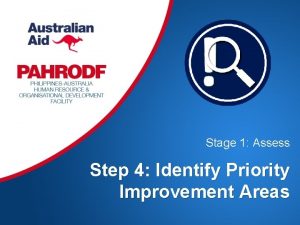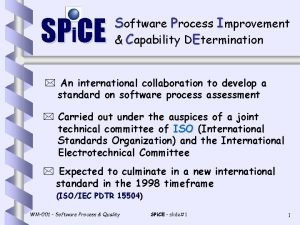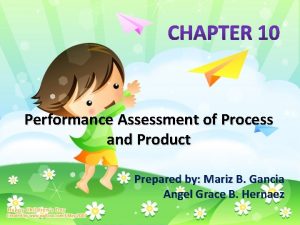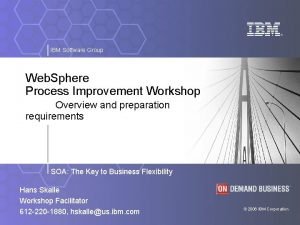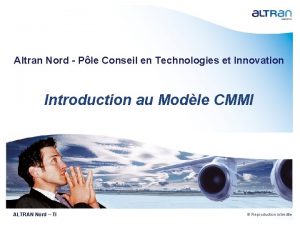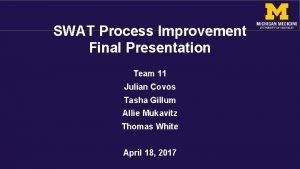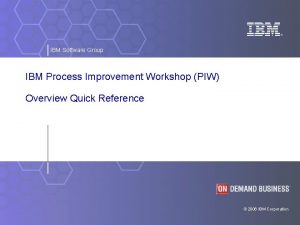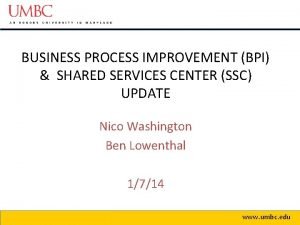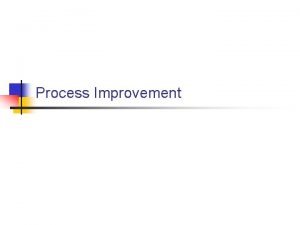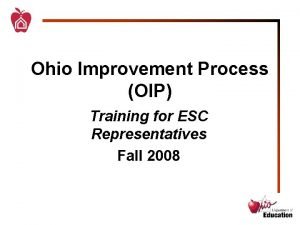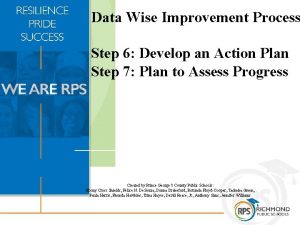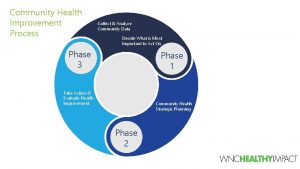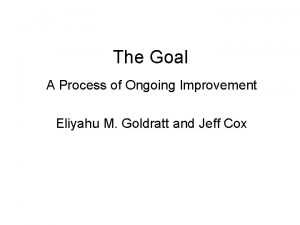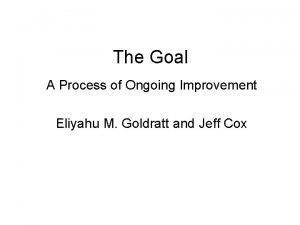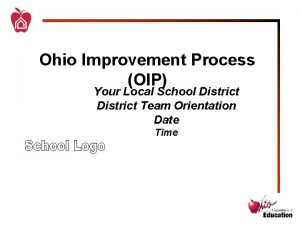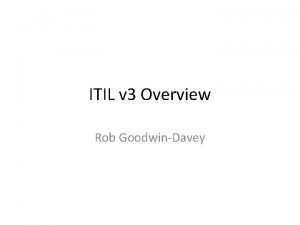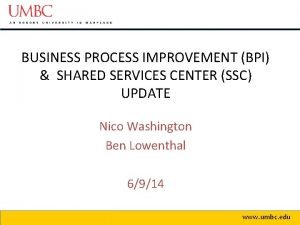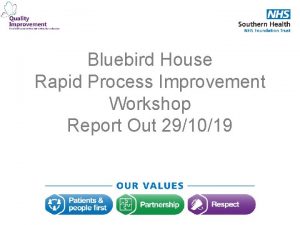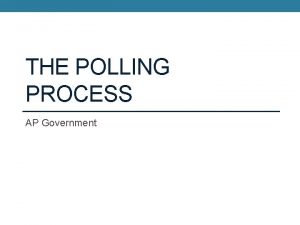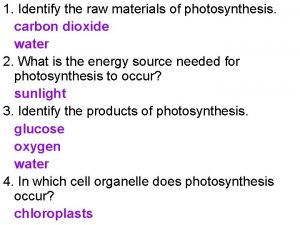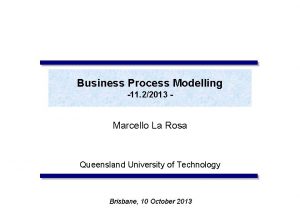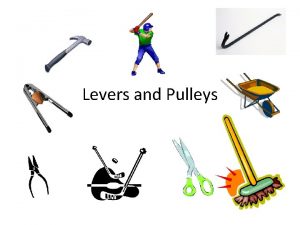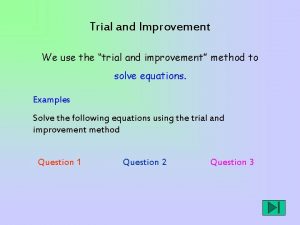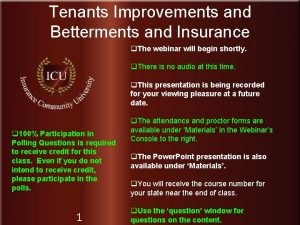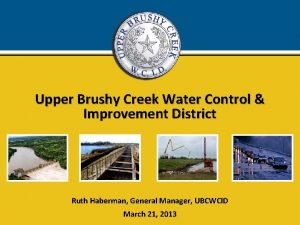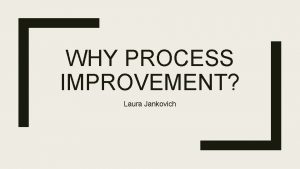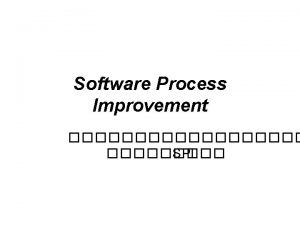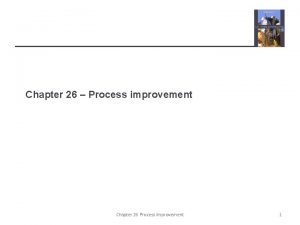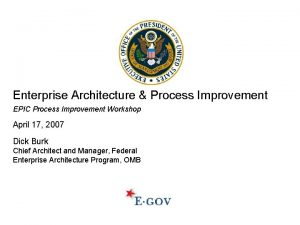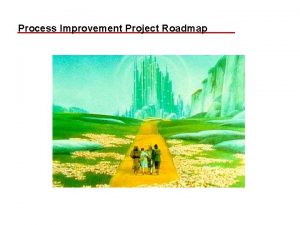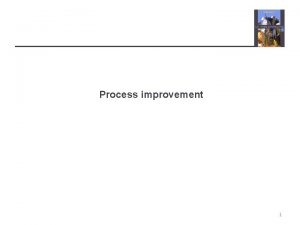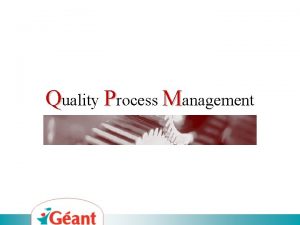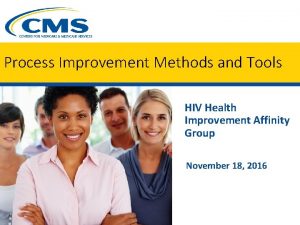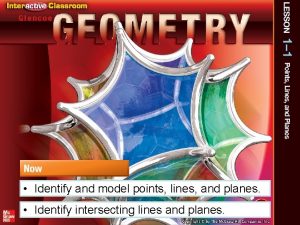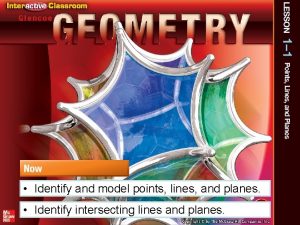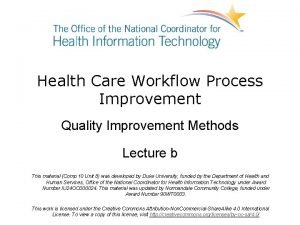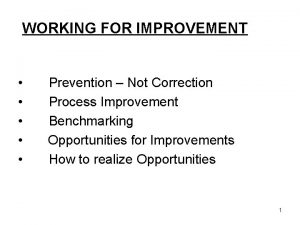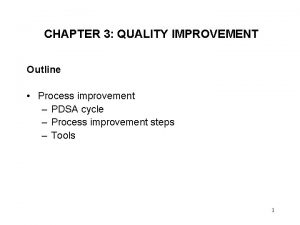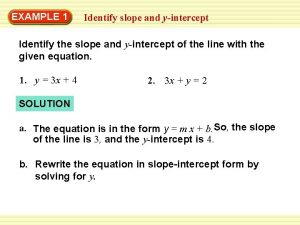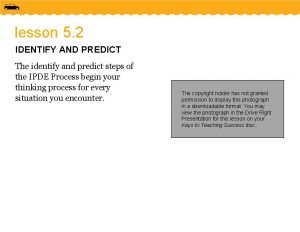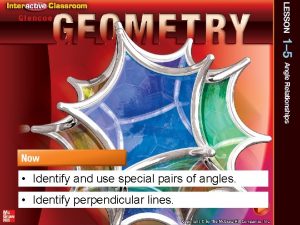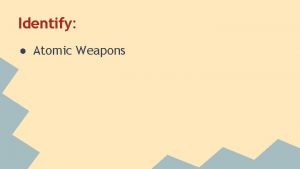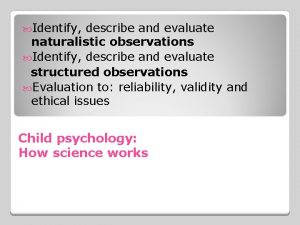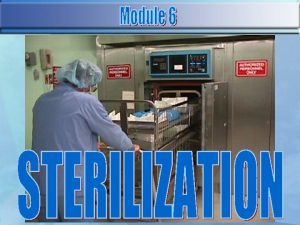Process Improvement and Management Process Improvement Identify a


































- Slides: 34

Process Improvement and Management Process Improvement • • • Identify a Critical Business Issue/Opportunity Identify the process(es) Describe and analyze the “Is” Process Design the “Should” Process Implement changes Process Management • Manage individual process for continuous improvement • Manage our Organization as an Adaptive System Pritchett, LLC • Copyright © 1

The Organization as an Adaptive System ENVIRONMENTAL INFLUENCES environmental group actions interest rates regulations $ • Culture • Economy • Government ANY BUSINESS RESOURCES $ $ Shareholders Capital Market Labor Market capital human resources budgets Finance strategy, goals staff Human Resources automated solutions materials, equipment Suppliers Research Laboratories Manufacturing designs technology resources Pritchett, LLC • Copyright © Research and Development design feedback new product ideas COMPETITION products orders Management MARKET Information Services products/ services Customers Distribution Marketing and Sales orders, requirements, and feedback products/services 2

Three Levels of Performance I. Organization Level Strategy Structure Policy Measurement System ANY BUSINESS II. Process Level Workflow III. Job/Performer Level Suppliers Pritchett, LLC • Copyright © Skills Knowledge Ability Rewards Customers 3

Process Definition A series of steps which, through the use of resources, convert one or more inputs into one or more outputs that together create value for the customer. Process Input Supplier Pritchett, LLC • Copyright © Output Step 1 Step 2 Step 3 Customer 4

Pritchett’s Process Improvement and Management Methodology Phase 5 Managing the Organization as an Adaptive System strategy Phase 0 Performanc e Improvement Planning performance improvement plan core processes without issues Phase 4 core processes without issues core processes with issues Pritchett, LLC • Copyright © Process Management optimal process performance Phase 33 Phase 11 Project Definition optimal organization performance project goals, roles, and boundaries Managing improved Implementation process & Change Phase 2 Proces s Analysis and Design “should” process recommendations, and preliminary implementation plan 5

Phase 0 - Performance Improvement Planning Phase 5 Managing the Organization as an Adaptive System Phase 0 Performance Improvement Planning Phase 4 Phase 3 Phase 2 Phase 1 Project Definition Strategy Process Management Managing Implementation & Change Process Analysis & Design • Strategy validated/clarified • Critical Success Factors and Critical Business Issues/Opportunities identified • Core processes identified • Process actions determined • Performance Improvement Plan developed Pritchett, LLC • Copyright © Performance Improvement Plan and Critical Business Issues/ Opportunities 6

From Mission to CBI to Performance Improvement Mission—Vision—Values Strategy Critical Success Factors Critical Business Issues/Opportunities Processes Customer Service Product Development Quality Time Customer Satisfaction Cost Performance Improvement Plan Sales Forecasting Finance Pritchett, LLC • Copyright © 7

Phase 1 - Project Definition Phase 5 Managing the Organization as an Adaptive System Phase 0 Performance Improvement Planning Phase 4 Phase 3 Phase 2 Phase 1 Project Definition Performance Improvement Plan and Critical Business Issues / Opportunities Process Management Managing Implementation & Change Process Analysis & Design • Process boundaries established • Critical Process Issues identified • Project Goals established Project Goals, Roles, and Boundaries • Constraints and Assumptions identified • Project Roles defined • Project Plan developed Pritchett, LLC • Copyright © 8

From Critical Business Issues / Opportunities to Project Goals Example Performance Improvement Planning Mission/Vision/ Value Strategy • To be # 1 in their niche market • Identify and grow key markets Critical Business Issue/Opportunity • Losing market share Project Definition Process • New Product Development • Customer Order Fulfillment Critical Process Issue • We need to reduce cycle time for fulfilling customer orders Project Goal(s) • Within 3 months deliver materials in < 20 days • Within 6 months deliver materials in < 10 days Pritchett, LLC • Copyright © 9

Typical Process Improvement Project Roles Process Owner Executive Team Steering Team Process Improvement Facilitator P R O C E S S Pritchett, LLC • Copyright © Team Leader Design Team 10

Maps as Tools Supersystem Map • Phase 0 • Senior Management • Identify CBI Process Relationship Map • Phase 0 • Senior Management • Impact & Priority Function Relationship Map (General) • Phase 1 • Senior Management • Understand & Manage Function Relationship Map (Specific) • Phase 1 • Senior Management • Team Membership Cross-Functional Process Map • Phase 2 • Design Team • Workflow Pritchett, LLC • Copyright © 11 11

Tool: Function Relationship Map Definition A picture of the functions in our organization as a system and the input/output relationships among them. Uses To help understand, analyze, improve and manage our organization’s functional relationships: – General relationships of all functions – Specific relationships that exist within a process or around a critical business issue Pritchett, LLC • Copyright © 12

Function Relationship Map (General)—Template CORPORATION RESOURCES DIVISION MARKET Customers Department A Department B Pritchett, LLC • Copyright © 13

Function Relationship Map (Specific)—Template CORPORATION RESOURCES DIVISION MARKET Customers Pritchett, LLC • Copyright © 14

Phase 2 - Process Analysis and Design Phase 5 Managing the Organization as an Adaptive System Phase 0 Performance Improvement Planning Phase 4 Phase 3 Phase 1 Project Definition Phase 2 Process Management Managing Implementation & Change Process Analysis & Design • “IS” Process documented • Disconnects identified Project Goals, Roles, and Boundaries • “SHOULD” Specifications designed and tested • “SHOULD” Process designed • Process Measures developed “SHOULD” Process, Recommendations, and Implementation Strategy • Recommendations and Implementation Strategy developed and approved Pritchett, LLC • Copyright © 15

Tool: Process Map Definition A picture of the sequenced steps that convert input(s) to output(s) Uses • Document “Is” process for understanding and analysis • Document “Should” process for implementation and continuous improvement • Document Linear workflows • Document Cross-functional workflows Pritchett, LLC • Copyright © 16

Product concept tested 15 feedback no Volume estimated price parameters determined 18 volume/price data 4 New product proposals made 6 needs • Scans updated • 216 LF calculated 8 Product priorities established 9 Product proposals OKd 11 approved proposals Updated database Product profile developed 12 cost estimates proposals yes product profile Proposal OK? produc t profile Product devel’t schedule set Feasibility study prepared 20 Feasibility study reviewed 21 Go? 22 STOP • Project plan develope d • Funds budgeted • Cost parameteplan/schedule rs set • Schedule set product profile 216 LF data Product proposals reviewed 7 product profile strategy profile templates Product strategy developed 2 Product business plan devel’d study test data report Support needs identified 17 proposals Needs, profiles selected PROPS -D PROP report proposal templates APD NSD Market needs ident’d 3 • regional/national demand • competitor data Product Design Management customer profile analyses/strategies Marketing needs Needs evaluated priority report Sales Customer Needs needs Identified identified 1 reactions Updated planning capability Materials and resources info. sent 5 Pritchett, LLC • Copyright © Quotes requested 10 RFPs Suppliers Product Engineering Finance Systems Product evaluated 14 needs Customers / Markets Cross-Functional Process Map: Example - Product Development price quotes Product cost estimated 16 19 23 Quotes supplied 13 17

Disconnects DISCONNECT: Anything that negatively impacts the effectiveness or efficiency of a process. Organization Level Disconnects POLICY MANUAL Strategy Organization Structure Policy Process Level Disconnects Process A Information Flow Process B Input/Supplier Process Flow Job/Performer Level Disconnects JOB DESCRIPTION • ---- • ----- Roles/Responsibilities Pritchett, LLC • Copyright © DIPLOMA Skills Job Environment 18

Process Analysis and Design: “IS” Map • Critical Process Issue • Goals “IS” Process Map with Disconnects Xxx Xxxxxx Xxxxx 4 7 1 2 8 9 10 6 5 3 Benchmark Data Stakeholder wants / needs / wishes Assumptions / Constraints “SHOULD” Design Specifications CBI / CPI Project Goals Characteristics Risks “Could Be” M IT Assumptions Benefits “SHOULD” Sub-Processes Linear Process Maps “SHOULD” Process Map Xxx Xxxxxx Xxxxx Pritchett, LLC • Copyright © 19

Process Analysis and Design: “SHOULD” Map • Critical Process Issue • Goals “IS” Process Map with Disconnects Xxx Xxxxxx Xxxxx 4 7 1 2 8 9 10 6 5 3 Benchmark Data Stakeholder wants / needs / wishes Assumptions / Constraints “SHOULD” Design Specifications CBI / CPI Project Goals Characteristics Risks “Could Be” Assumptions M IT Benefits “SHOULD” Sub-Processes Take Make Ship Invoice Linear Process Maps “SHOULD” Process Map Xxx Xxxxxx Xxxxx Pritchett, LLC • Copyright © 20

Process Measures Where would you place a measure? Process Supplier Pritchett, LLC • Copyright © Custome r 21

Process Measures M 1 -I M 2 B A R M 2 C FUNCTION CUSTOME M 2 M 1 -E M 1 -I M 2 Pritchett, LLC • Copyright © External / Customer Measures Internal / Business Measures Subprocess Measures 22

Process Analysis and Design: “SHOULD” Map • Critical Process Issue • Goals “IS” Process Map with Disconnects Xxx Xxxxxx Xxxxx 4 7 1 2 8 9 10 6 5 3 Benchmark Data Stakeholder wants / needs / wishes Assumptions / Constraints “SHOULD” Design Specifications CBI / CPI Project Goals Characteristics Risks “Could Be” Assumptions M IT Benefits “SHOULD” Sub-Processes Take Make Ship Invoice Linear Process Maps “SHOULD” Process Map Xxx Xxxxxx Xxxxx Pritchett, LLC • Copyright © 23

Linear Process Map Template / Example Requirements identified requirements 1 Market and account information assessed info 2 Gap of available information closed? Y 3 Communication program & objectives identified 4 program/ objectives Capacity available? Y 5 N N objective Information gathered info 6 Objective defined 7 Obj’s & customer readiness in sync? 8 N Pritchett, LLC • Copyright © 24 Y

How to Construct a Linear Process Map 1. Identify an accomplishment (step) and/or decision that begins the process. Order placed 2. 1 Then place the accomplishments (boxes) and decision points (diamonds) in the order in which they usually occur in the process. Form reviewed for completeness 12 form Completed? 13 N 3. Form processed 14 Y form Form returned to Sales 15 Connect the boxes and diamonds with arrows and label them. finished product Pritchett, LLC • Copyright © Product shipped 33 product 25

Process Analysis and Design: “SHOULD” Map • Critical Process Issue • Goals “IS” Process Map with Disconnects Xxx Xxxxxx Xxxxx 4 7 1 2 8 9 10 6 5 3 Benchmark Data Stakeholder wants / needs / wishes Assumptions / Constraints “SHOULD” Design Specifications CBI / CPI Project Goals Characteristics Risks “Could Be” Assumptions M IT Benefits “SHOULD” Sub-Processes Take Make Ship Invoice Linear Process Maps “SHOULD” Process Map Xxx Xxxxxx Xxxxx Pritchett, LLC • Copyright © 26

How to Construct a Cross-Functional Process Map 1. Draw bands. 2. Identify the customer, functions and suppliers to be represented on the bands. The first band is typically reserved for the customer. Customer A B C D E Suppliers 3. Identify the Sub-Processes (if possible). Order Entry Customize Manufacture Ship Install Customer A B C D E Suppliers Cont’d Pritchett, LLC • Copyright © 27

How to Construct a Cross-Functional Process Map (Cont’d) 4. Place the first step in the appropriate band. Indicate the step’s activity with a noun and a verb in the past tense. Order Entry Customize Manufacture Ship Install Customer A B C D E Suppliers 5. Identify the output and where it goes. Place another step in the appropriate band label the step. Draw an arrow from the output side of the previous step to this step and label the arrow with the output. Order Entry Customize Manufacture Ship Install Customer A B C D E Suppliers 6. Continue by asking what is accomplished or completed in this step? What is the output and where does it go? Order entry Customize Manufacture Ship Install Customer A B C D E Suppliers 7. Revise map as needed. Number the boxes from top to bottom and left to right. Pritchett, LLC • Copyright © 28

Phase 3 - Managing Implementation and Change Phase 5 Managing the Organization as an Adaptive System Phase 0 Phase 4 Performance Improvement Planning Phase 3 Phase 1 Phase 2 Project Definition Process Management Managing Implementation & Change Process Analysis & Design IMPLEMENTATION PLANNED “SHOULD” Process, Recommendations, and Implementation Strategy • Implementation Team Structure • Detailed Implementation Plans • Overall Integrated Implementation Plan IMPLEMENTATION EXECUTED Improved Process • Changes Developed • Receiving Organizations Prepared • Cutover to New Process IMPLEMENTATION ASSESSED • Process Performance Stabilized • Performance Targets Achieved • Success Celebrated Pritchett, LLC • Copyright © 29

Possible Areas of Change IMPLEMENTATION Organization Level POLICY MANUA L Strategy Policy Values and Behaviors Changed Organization Structure Measurement Process Level Process Analysis and Design Process A Process Flow Information Flow Process B Input/Supplier Process Management Measurement Job/Performer Level JOB • DESCRIPTION ---------- • ----- • ----- Roles Pritchett, LLC • Copyright © DIPLOMA Skills Communication Human Performance System Measurement 30

Managing Implementation and Change Infrastructure Roles Executive Team Process Owner Project Manager Process Improvement Facilitator Policy Team Process Implementation Steering Team Communications Team Process Team Systems Team Job Design/Job Environment Team Change Management Team Pritchett, LLC • Copyright © Implementation Teams Organization Design Team Process Measurement and Management Team 31

Managing Implementation and Change Model Performance Planning and Management Implementation Detailed Implementation Planned Implementation Executed Implementation Assessed Change Management Communications Pritchett, LLC • Copyright © 32

Phase 4 - Process Management Phase 5 Managing the Organization as an Adaptive System Phase 0 Performance Improvement Planning Phase 4 Phase 3 Phase 1 Project Definition Improved or Healthy Process Phase 2 Process Management Managing Implementation & Change Process Analysis & Design • Individual processes managed for optimal performance • Management roles and responsibilities clarified —Process Owner —Process Management Team • Measurement system in place • Performance planned, supported and managed Pritchett, LLC • Copyright © Optimal Process Performance 33

Phase 5 - Managing the Organization as an Adaptive System Phase 5 Managing the Organization as an Adaptive System Phase 0 Performance Improvement Planning Phase 4 Phase 3 Phase 1 Project Definition Performance Improvement (or) Optimal Process Performance Phase 2 Process Management Managing Implementation & Change Process Analysis & Design • The organization is managed as an integrated system of processes • All three levels of performance are integrated • System performance is planned and managed • Performance is monitored analyzed using the integrated measurement system —Leading and lagging indicators —External and internal variables Pritchett, LLC • Copyright © Optimal Organization Performance 34
 Identifying priority improvement areas
Identifying priority improvement areas Software process improvement and capability determination
Software process improvement and capability determination Identify the performance process and product
Identify the performance process and product Identify and explain the research process.
Identify and explain the research process. Process improvement workshop examples
Process improvement workshop examples Standard cmmi appraisal method for process improvement
Standard cmmi appraisal method for process improvement Swat presentation
Swat presentation Itil service lifecycle continual service improvement
Itil service lifecycle continual service improvement Ibm process improvement
Ibm process improvement Shared services process improvement
Shared services process improvement Test improvement process
Test improvement process Community health improvement process
Community health improvement process Rpiw process
Rpiw process Oip training
Oip training Datawise norms
Datawise norms Wnchi
Wnchi Herbie the goal
Herbie the goal The goal boy scout hike
The goal boy scout hike Rapid process improvement
Rapid process improvement Oip process
Oip process Step 1 in 7 step improvement process
Step 1 in 7 step improvement process Umbc ap credit chart
Umbc ap credit chart Rapid process improvement workshop
Rapid process improvement workshop Steps of polling process
Steps of polling process Identify the process
Identify the process Starting materials for cellular respiration
Starting materials for cellular respiration Top management and middle management
Top management and middle management Management pyramid
Management pyramid Top management and middle management
Top management and middle management Business process levels
Business process levels Identify the lever and label the load effort and fulcrum
Identify the lever and label the load effort and fulcrum Trial and improvement
Trial and improvement You cannot improve what you cannot measure explain
You cannot improve what you cannot measure explain Tenant improvement and betterments
Tenant improvement and betterments Brushy creek water
Brushy creek water
